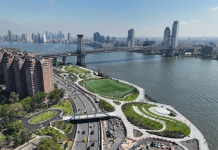
John Shapiro, an urban planner working with Community Board 3’s SPURA task force, said it succinctly last week: “There’s not much here to work with, quite frankly.” He was talking about the results of a game in which participants were asked to make hard choices about the future of the former Seward Park Urban Renewal Area.
Using colorful charts projected on the wall of a school cafeteria, he noted several areas of general agreement on issues like open space, retail uses and parking. But on the contentious topic of affordable housing, Shapiro reported, “There is no pattern to your answers.”
Thursday’s meeting, the third of four sessions Shapiro is facilitating, did not appear to move the committee any closer to resolving differences that for 43 years have prevented the redevelopment of the 7-acre site next to the Williamsburg Bridge. In fact, some factions in the community appeared to be hardening their positions. At the end of the evening, CB3 leaders suggested participants use a summer hiatus to decide if they’re more interested in compromise or sustained conflict.
The first part of the meeting was reserved for comments from the general audience. Ed Rudyk, a displaced SPURA tenant, spoke for a group of residents who have close ties to the local advocacy organization, Good Old Lower East Side (GOLES).
Citing last month’s meeting, in which residents were not permitted to speak until the end of the evening, Rudyk alleged, “The process… has been neither communal nor inclusive… exclusivity was the order of the day.” The whole process, he said, “felt like an ambush.”
“By setting artificial constraints — ruling out the possibility of subsidies, demanding market rate housing… insisting any changes in zoning would prove too complicated and prohibitively expensive, and finally, declaring the project must be economically viable and pay for itself — Mr. Shapiro hijacked the process from the committee and the community.”
Rudyk said GOLES and “other community groups” would hold, “public meetings in September to develop community scenarios,” and he invited “the community board and any interested party to work with us…” Finally, he called on the city to, “make restitution” to the former site tenants by “designating the entire SPURA site a community land trust, guaranteed to be set aside in perpetuity for the purpose of building a mix of housing, which must primarily include original site tenants, as well as ‘extremely low,’ ‘very low,’ and ‘low income,’ families.”
Other residents, representing differing points of view, spoke out, as well. Brett Leitner, who lives in the Seward Park Cooperative, introduced a new group advocating for compromise. SHARE (Sustainable Housing and Retail Expansion) is calling for an end to the “rancor and ill-will” that has dominated the SPURA debate for decades, and believes whatever is developed “should be for everyone.” Leitner said the group would “embrace the history of the neighborhood,” but also recognize that it is in the “midst of change for the better.” Asserting that the SPURA plan should include both affordable and market rate housing, he said, “an all-or-nothing approach does not suit anyone’s needs.”
Another Grand Street resident, David Bolotsky, noted his grandfather’s business was among hundreds of shops and apartments bulldozed when the government condemned the SPURA parcels in 1967. His family lived in the middle-income Hillman Cooperative, part of the so-called “Jewish projects,” so they were not uprooted from their community. Alluding to a series of anti-discrimination lawsuits filed against the Grand Street Cooperatives by non-Jewish residents, Bolotsky said there is a legitimate need for low-income housing on SPURA. But calling for a mix of affordable and market rate apartments, he urged all sides to find common ground. Otherwise, he said, “our children and grandchildren will be looking at a beautiful dirt patch for the next 100 years.”
After the public speaking session, Shapiro addressed some of the concerns about last month’s “game playing.” Responding to complaints that the exercise made several unpopular assumptions, heexplained, “The game was an attempt to confront some of the realities that we’ve been handed… The silent participant on this committee, which is in essence the city, has given us certain constraints.”

In the past, Shapiro has summed up the city’s position about subsidizing the Seward Park project by saying, “If you can’t make the private sector work for the public benefit here, where can you make it work?” In other words, the Bloomberg administration believes it’s doing quite a lot for the neighborhood by agreeing to sell the parcels for “less than top dollar.”
Thursday night, city officials spoke for themselves, using overhead graphics to explain their thinking on SPURA financing and zoning issues. In steeply discounting the most valuable building site the city owns, it expects any future developer to build a significant amount of affordable housing. The city would not charge the developer property taxes, which officials argued, is a kind of subsidy. They also addressed questions from residents, who have asked why bonds can’t be issued, which is what happened in the Hudson Yards project. The answer: Hudson Yards is a far larger development that required large-scale infrastructure improvements well beyond what any developer could afford to pay.
As for zoning, Edith Hsu-Chen of the City Planning Dept. walked community board members through a tutorial on “upzoning.” In past meetings, some task force members have called for zoning changes to allow larger buildings, and more apartments.
There are 10 sites available for development. The rezoning of the Lower East Side two years ago placed height caps on the parcels north of Delancey Street. For this reason, residential development is likely to be focused below Delancey. Right now, sites 3. 4, 5 and 6 are zoned R-8 — just like the 20-story Seward park Cooperative on the south side of Grand Street. Hsu-Chen suggested the city would almost certainly be opposed to “upzoning” to R-10, which would allow for towers in excess of 40 stories.
If current zoning remains in place, officials have estimated between 800-1000 residential units could be built in a mixed-use project that also includes retail, offices and community spaces. To give community members an idea of how upzoning could impact the project, they zeroed in on sites 3 through 6. On those parcels, moving up to R-9 would likely allow for another 350 apartments.
But David Quart of the Economic Development Corp. said there are at least two major drawbacks to upzoning. First, putting up larger buildings would require an additional $40 million in infrastructure and other construction-related improvements. Second, he indicated, 80% of the apartments would need to be market rate in order to pay for the added sewer and street upgrades.
Shapiro told committee members, “It’s all about trade-offs.” The community (or parts of it) might want affordable housing, a park, a community center, a school. But in order to pay for those things, Shapiro advised, the project must include other “revenue producing” things (such as a hotel and/or medium box stores).
Shapiro said he doesn’t see a need for office space in the SPURA project. As the Manhattan real estate market struggles to emerge from the economic downturn, he theorized there would be little demand for offices on the Lower East Side anytime soon. But Bob Zuckerman, executive director of the LES Business Improvement District, disagreed. The right kind of offices, he said, could help revitalize the neighborhood. Zuckerman urged the committee to consider shared office spaces, incubators and other non-traditional solutions for entrepreneurs and creative people.
Throughout the evening, Shapiro steadfastly avoided talking directly about affordable housing. At some point, committee members will have to agree on numbers – the percentages of low, middle and market rate apartments to be built on SPURA. But Shapiro made it clear he does not believe the panel is ready to address the issue. In the six weeks before the final facilitated session, Shapiro said he wanted to consult with new “stakeholders,” such as the SHARE coalition.
Damaris Reyes, executive director of GOLES, called on CB3 to extend the process. “We need to slow down some,” she said. David McWater, task force chairman, urged members to go back to their neighbors, and to think about whether compromise is possible. There might never be a better time, McWater argued, to make a deal with the city, theorizing that third term Mayor Michael Bloomberg has no reason to fear political repercussions from redevelopment opponents. Dominic Pisciotta, CB3 chairman, said “I don’t want to slow down.” While acknowledging a need for outreach across the community, he said there can be, “No stalling… We need to call each others’ bluff.”










